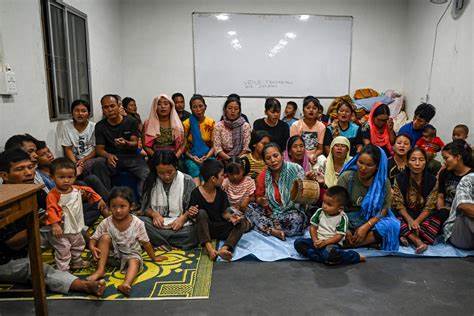In 2023, Forced to flee: Despair after India deadly ethnic clashes

In 2023, Forced to flee: Despair after India deadly ethnic clashes
In India’s troubled Manipur state, deadly ethnic violence has caused divisions among communities, with both sides sharing similar stories of loved ones being killed, homes being set on fire, and many forced to live in camps. The armed clashes between the predominantly Hindu Meitei majority and the mainly Christian Kuki have resulted in the deaths of at least 120 people since May, and some believe the actual number of casualties could be even higher.
The conflict’s root causes, historical grievances, economic disparities, and political marginalization, need to be addressed, and efforts should focus on fostering dialogue, reconciliation, and understanding between the communities. Additionally, humanitarian support must be provided to those affected, with the ultimate goal of facilitating safe returns and promoting peaceful coexistence among all groups.
Around 50,000 individuals, including teacher Ranjana Moirangthem, have been compelled to flee due to the ongoing ethnic violence in Manipur. Ranjana, a Meitei residing in an area now dominated by the Kuki community in Churachandpur, experienced a harrowing night where she and 25 neighbors took shelter in a cramped room while gun battles between gangs raged nearby. The situation became so dire that the army had to evacuate them.
During the chaotic escape, Ranjana left with only the clothes on her back, leaving behind her crucial education certificates required for finding work. The displacement has left her in a vulnerable state, with uncertainties about her future and livelihood prospects.
Later, Ranjana Moirangthem reached out to a Kuki friend to try and retrieve her vital documents, but her friend informed her that her home was likely one of the thousands that had been set ablaze during the violence.
As a former teacher, Ranjana feels lost without the documents that prove her qualifications. The loss of her educational certificates has left her uncertain about her future and the possibility of resuming her career.
Currently, she resides in a crowded camp in Moirang district, where she relies on government aid and charitable support for survival. The camp accommodates around 250 people, and the living conditions are cramped, with mattresses covering every available space on the floor.
Despite the hardships, Ranjana yearns to return to Churachandpur, her hometown where she has spent her entire life. The deep connection she has with the place makes her desire to reclaim her life there, but the devastation caused by the violence has made it difficult for her to envision a swift return.
The situation in the region remains precarious, with many homes being destroyed by fire, leaving countless individuals displaced and seeking refuge in crowded camps. The violence has caused immeasurable suffering, leaving people like Ranjana with a profound longing for the safety and familiarity of their once-peaceful homes.
L. Sonia, another Meitei residing in the same crowded camp, recounted her desperate attempts to seek help from local politicians when gangs wreaked havoc in her neighborhood in Churachandpur.
“Why set our houses on fire?” she exclaimed in frustration. Sonia pointed out that the conflict was between the gangs and the government, and innocent civilians like her community should not have been subjected to such violence.
She expressed her dismay at the lack of options for people like her who have lost their homes. While people displaced by natural disasters like floods may eventually return to their homes once the situation stabilizes, the situation for those affected by ethnic violence is far more complicated and uncertain.
The northeastern states of India, located between Bangladesh, China, and Myanmar, have a long history of tensions among various ethnic groups. These regions have often been described as a “tinderbox” due to the underlying complexities and historical grievances that fuel conflicts among different communities.
The plight of people like Ranjana and Sonia highlights the tragic consequences of such ethnic tensions, as innocent individuals are caught in the crossfire and forced to endure immense hardships and uncertainty. Efforts to address the root causes of these conflicts and promote peaceful coexistence are essential to bring stability and security to the region.
In Manipur, the conflict has arisen from a combination of factors, including competition for land and public jobs, contributing to the tense situation. Both sides involved in the conflict hold the state and national government responsible for not effectively preventing the violence.
India’s Interior Minister Amit Shah has assured an “impartial investigation” into the violence and has pledged solidarity with the people of Manipur. However, despite these promises, the violence persists, leaving thousands of people homeless and frustrated.
Sonia, among those who have lost their homes, passionately appealed to Indian Prime Minister Narendra Modi for help. She expressed her anguish, questioning why their plight seems to be overlooked, and whether they are not considered Indian citizens deserving of support.
The communities in Manipur have become deeply divided due to the ongoing conflict. In areas like Churachandpur, Meitei people, like Sonia, no longer feel welcomed and face heightened hostility.
The situation in Manipur remains complex and sensitive, with significant challenges for the government and authorities to address the root causes of the conflict and provide effective solutions. Healing the divisions and rebuilding trust among the affected communities is essential to achieve lasting peace in the region.
The situation in Churachandpur district remains highly tense and fraught with fear and violence. Symbolic displays of hostility can be seen, with dummy coffins lining the route as a chilling warning to the Meitei community. Additionally, road signs bearing the Churachandpur name have been vandalized, highlighting the deep divisions between the different ethnic groups.
The Kuki community has constructed a poignant memorial, a bamboo hut adorned with images of their people who lost their lives in the conflict, including the youngest victim, a two-month-old baby. Messages at the memorial convey a determination that their sacrifices will not be in vain.
In the camps for displaced Kuki individuals, stories of horror and loss abound. Vaneilhing, a 40-year-old mother-of-two, narrated how a mob, dressed in black, descended upon her house, looted it, and set it on fire, forcing her and many others to flee for their lives.
The daily reality in the camps is one of sorrow and fear. Displaced individuals, including Vaneilhing, are traumatized and constantly on edge, afraid of potential reprisals. The emotional toll is overwhelming, with tears and grief becoming a regular part of their lives.
The Kuki community seeks solace in nightly gatherings at a makeshift chapel, praying and singing hymns as a way to cope with the ongoing violence and the presence of vigilante militia forces.
Despite a glimmer of joy in the birth of a baby in the camp, the future remains uncertain for this new life. Vaneilhing expresses concern about what lies ahead for the child in the midst of the conflict. The violence and displacement have disrupted the lives of thousands, leaving them grappling with deep uncertainty and hardship.
The situation in Churachandpur district is heart-wrenching, with communities torn apart by violence, grief, and despair. Addressing the root causes of the conflict and fostering reconciliation and understanding between the ethnic groups is essential to bring lasting peace and stability to the region.






